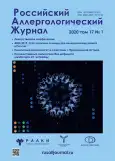Surprises of food anaphylaxis: a clinical case
- Authors: Lepeshkova T.S1,2, Beltyukov EK1
-
Affiliations:
- Ural State Medical University
- «Children's hospital № 13»
- Issue: Vol 16, No 4 (2019)
- Pages: 42-47
- Section: Articles
- URL: https://journals.rcsi.science/raj/article/view/121455
- DOI: https://doi.org/10.36691/RAJ.2020.16.4.005
- ID: 121455
Cite item
Full Text
Abstract
Full Text
##article.viewOnOriginalSite##About the authors
Tatyana S Lepeshkova
Ural State Medical University; «Children's hospital № 13»
Email: levlpa@mail.ru
кандидат медицинских наук, врач аллерголог-иммунолог Ekaterinburg, 620028, Russian Federation
E K Beltyukov
Ural State Medical Universityдоктор медицинских наук, профессор кафедры факультетской терапии, эндокринологии, аллергологии и иммунологии Ekaterinburg, 620028, Russian Federation
References
- Food Allergy and Anaphylaxis Guidelines. Translating knowledge into clinical practice. EAACI. 2014;69(8):1008-1025. doi: 10.1111/all.12429.
- Simons FE, Sampson HA. Anaphylaxis epidemic: factor fiction? J Allergy Clin Immunol. 2008;122(6):1166-1168. doi: 10.1016/j.-jaci.2008.10.019.
- L0vik M, Namork E, Faste C, Egaas E. The Norwegian National Reporting System and Register of Severe Allergic Reactions to Food. Norsk Epidemiologi. 2004;14:155-160. doi: 10.5324/nje.v14i2.238.
- Sicherer SH, Sampson HA. Food allergy. J Allergy Clin Immunol. 2010;125(2 Suppl 2):116-125. doi: 10.1016/j.-ja-ci.2009.08.028.
- Järvinen KM, Sicherer SH, Sampson HA, Nowak-Wegrzyn A. Use of multiple doses of epinephrine in food-induced anaphylaxis in children. J Allergy Clin Immunol. 2008;122:133-138. doi: 10.1016/j.jaci.2008.04.031.
- Simons FER, Ebisawa M, Sanchez-Borges M et al. 2015 Update of the evidence base: World Allergy Organization anaphylaxis guidelines. World Allergy Organ J. 2015;8(1):32. doi: 10.1186/s40413-015-0080-1.
- Sampson HA, Munoz-Furlong A, Campbell RL et al. Second symposium on the definition and management of anaphylaxis: summary report - Second National Institute of Allergy and Infectious Disease/Food Allergy and Anaphylaxis Network symposium. J Allergy Clin Immunol. 2006;117:391-397. doi: 10.1016/j.-jaci.2005.12.1303.
- Jerschow E, Lin RY, Scaperotti MM et al. Fatal anaphylaxis in the United States, 1999-2010: Temporal patterns and demographic associations. J Allergy Clin Immunol. 2014; 134:1318-1328.e7. doi: 10.1016/j.jaci.2014.08.018.
- Khodoun MV, Strait R, Armstrong L et al. Identification of markers that distinguish IgE from IgG mediated anaphylaxis. Proc Natl Acad Sci USA. 2011;108:12411248. DOI: 10.1073/ pnas.1105695108.
- Simons FER, Ardusso LRF, Bilo MB et al. World Allergy Organization Guidelines for the assessment and management of anaphylaxis World Allergy Organ J. 2011;2:13-37. doi: 10.1097/WOX.0b013e318211496c.
- Muraro A, Roberts G, Worm M et al. Anaphylaxis: guidelines from the European Academy of Allergy and Clinical Immunology. Allergy. 2014;69:1026-1045. doi: 10.1111/all.12437.
- Пампура АН, Конюкова НГ Анафилаксия к пищевым продуктам у детей раннего возраста. Российский вестник перинатологии и педиатрии. 2011;5:76-84
- Simons F, Peterson S, Black CD. Epinephrine dispensing patterns for an out of hospital population: a novel approach to studying the epidemiology of anaphylaxis. J Allergy Clin Immunol. 2002;110:647-651.
- Pumphrey RS, Roberts IS. Postmortem findings after fatal anaphylactic reactions. J Clin Pathol. 2000;53:273-276. doi: 10.1136/jcp.53.4.273.
- Варламов ЕЕ, Пампура АН. Значение клинико-лабораторного фенотипа прогнозирования течения аллергии к белкам коровьего молока. Вопросы современной педиатрии. 2013;12(6):19-22
- Dalal I, Binson I, Levine A et al. The pattern of sesame sensitivity among infants and children. Pediat Allergy Immunol. 2003;14:312-316. doi: 10.1016/S0091-6749(03)80902-8.
- Asero R, Mistrello G, Roncarolo D. Lipid transfer protein: a pan-allergen in plant-derived foods that is highly resistant to pepsin digestion. Int Arch Allergy Immunol. 2000;122(1):20-32.
- Werfel T, Asero R, Ballmer-Weber BK, Beyer K, Enrique E, Knulst AC et al. Position paper of the EAACI: food allergy due to immunological cross-reactions with common inhalant allergens. Allergy. 2015;70:1079-1090. doi: 10.1111/all.12666.6.
- Price A, Ramachandran S, Smith GP, Stevenson ML, Pomeranz MK, Cohen DE. Oral allergy syndrome (Pollen-food allergy syndrome). Dermatitis. 2015;26(2):78-88. DOI: 10.1097/ der.0000000000000087.
Supplementary files






